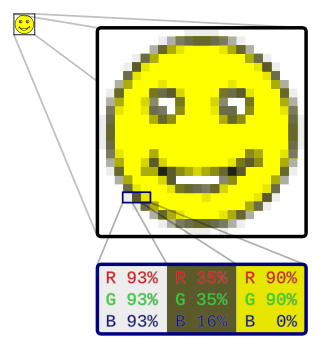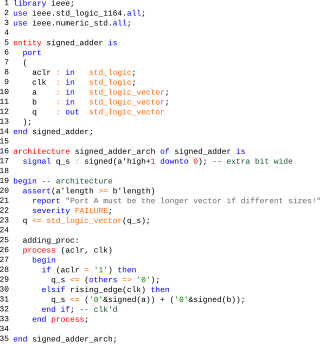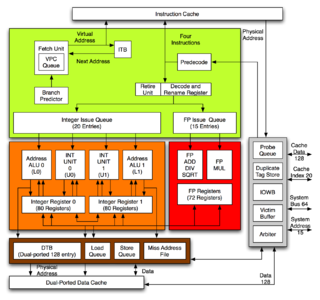Related Research Articles

Alpha is a 64-bit reduced instruction set computer (RISC) instruction set architecture (ISA) developed by Digital Equipment Corporation (DEC). Alpha was designed to replace 32-bit VAX complex instruction set computers (CISC) and to be a highly competitive RISC processor for Unix workstations and similar markets.

In computer graphics and digital photography, a raster graphic represents a two-dimensional picture as a rectangular matrix or grid of pixels, viewable via a computer display, paper, or other display medium. A raster image is technically characterized by the width and height of the image in pixels and by the number of bits per pixel. Raster images are stored in image files with varying dissemination, production, generation, and acquisition formats.

Digital electronics is a field of electronics involving the study of digital signals and the engineering of devices that use or produce them. This is in contrast to analog electronics which work primarily with analog signals. Despite the name, digital electronics designs includes important analog design considerations.
A signal generator is one of a class of electronic devices that generates electrical signals with set properties of amplitude, frequency, and wave shape. These generated signals are used as a stimulus for electronic measurements, typically used in designing, testing, troubleshooting, and repairing electronic or electroacoustic devices, though it often has artistic uses as well.

VHDL is a hardware description language that can model the behavior and structure of digital systems at multiple levels of abstraction, ranging from the system level down to that of logic gates, for design entry, documentation, and verification purposes. The language was developed for the US military VHSIC program in the 1980s, and has been standardized by the Institute of Electrical and Electronics Engineers (IEEE) as IEEE Std 1076; the latest version of which is IEEE Std 1076-2019. To model analog and mixed-signal systems, an IEEE-standardized HDL based on VHDL called VHDL-AMS has been developed.
OBEX is a communication protocol that facilitates the exchange of binary objects between devices. It is maintained by the Infrared Data Association but has also been adopted by the Bluetooth Special Interest Group and the SyncML wing of the Open Mobile Alliance (OMA). One of OBEX's earliest popular applications was in the Palm III. This PDA and its many successors use OBEX to exchange business cards, data, even applications.
This is an index of articles relating to electronics and electricity or natural electricity and things that run on electricity and things that use or conduct electricity.
ATPG is an electronic design automation method or technology used to find an input sequence that, when applied to a digital circuit, enables automatic test equipment to distinguish between the correct circuit behavior and the faulty circuit behavior caused by defects. The generated patterns are used to test semiconductor devices after manufacture, or to assist with determining the cause of failure. The effectiveness of ATPG is measured by the number of modeled defects, or fault models, detectable and by the number of generated patterns. These metrics generally indicate test quality and test application time. ATPG efficiency is another important consideration that is influenced by the fault model under consideration, the type of circuit under test, the level of abstraction used to represent the circuit under test, and the required test quality.
Modified frequency modulation (MFM) is a run-length limited (RLL) line code used to encode data on most floppy disks and some hard disk drives. It was first introduced on hard disks in 1970 with the IBM 3330 and then in floppy disk drives beginning with the IBM 53FD in 1976.
JTAG is an industry standard for verifying designs of and testing printed circuit boards after manufacture.

Alphanumeric Television Interface Controller (ANTIC) is an LSI ASIC dedicated to generating 2D computer graphics to be shown on a television screen or computer display.

Boundary scan is a method for testing interconnects on printed circuit boards or sub-blocks inside an integrated circuit (IC). Boundary scan is also widely used as a debugging method to watch integrated circuit pin states, measure voltage, or analyze sub-blocks inside an integrated circuit.

The Western Design Center (WDC) 65C02 microprocessor is an enhanced CMOS version of the popular nMOS-based 8-bit MOS Technology 6502. It uses less power than the original 6502, fixes several problems, and adds new instructions. The power usage is on the order of 10 to 20 times less than the original 6502 running at the same speed; its reduced power consumption has made it useful in portable computer roles and industrial microcontroller systems. The 65C02 has also been used in some home computers, as well as in embedded applications, including implanted medical devices.
Design for testing or design for testability (DFT) consists of IC design techniques that add testability features to a hardware product design. The added features make it easier to develop and apply manufacturing tests to the designed hardware. The purpose of manufacturing tests is to validate that the product hardware contains no manufacturing defects that could adversely affect the product's correct functioning.
Boundary scan description language (BSDL) is a hardware description language for electronics testing using JTAG. It has been added to the IEEE Std. 1149.1, and BSDL files are increasingly well supported by JTAG tools for boundary scan applications, and by test case generators.

The Alpha 21264 is a RISC microprocessor developed by Digital Equipment Corporation launched on 19 October 1998. The 21264 implemented the Alpha instruction set architecture (ISA).
The Alpha 21464 is an unfinished microprocessor that implements the Alpha instruction set architecture (ISA) developed by Digital Equipment Corporation and later by Compaq after it acquired Digital. The microprocessor was also known as EV8. Slated for a 2004 release, it was canceled on 25 June 2001 when Compaq announced that Alpha would be phased out in favor of Itanium by 2004. When it was canceled, the Alpha 21464 was at a late stage of development but had not been taped out.
Test compression is a technique used to reduce the time and cost of testing integrated circuits. The first ICs were tested with test vectors created by hand. It proved very difficult to get good coverage of potential faults, so Design for testability (DFT) based on scan and automatic test pattern generation (ATPG) were developed to explicitly test each gate and path in a design. These techniques were very successful at creating high-quality vectors for manufacturing test, with excellent test coverage. However, as chips got bigger and more complex the ratio of logic to be tested per pin increased dramatically, and the volume of scan test data started causing a significant increase in test time, and required tester memory. This raised the cost of testing.

The W65C816S is a 16-bit microprocessor (MPU) developed and sold by the Western Design Center (WDC). Introduced in 1985, the W65C816S is an enhanced version of the WDC 65C02 8-bit MPU, itself a CMOS enhancement of the venerable MOS Technology 6502 NMOS MPU. The 65C816 is the CPU for the Apple IIGS and, in modified form, the Super Nintendo Entertainment System.
In the electronics industry, embedded instrumentation refers to the integration of test and measurement instrumentation into semiconductor chips. Embedded instrumentation differs from embedded system, which are electronic systems or subsystems that usually comprise the control portion of a larger electronic system. Instrumentation embedded into chips is employed in a variety of electronic test applications, including validating and testing chips themselves, validating, testing and debugging the circuit boards where these chips are deployed, and troubleshooting systems once they have been installed in the field.
References
- The In-System Configuration Handbook: A Designer's Guide to ISC, Neil G. Jacobson, ISBN 1-4020-7655-X